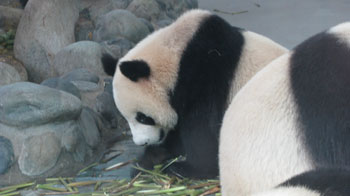Veterinarians join global disaster congress
Dr. Gary Vroegindewey said veterinarians are vital in planning for and responding to disasters, and a global conference this summer gave an opportunity to increase understanding of that role.
"It's critical as we look across the whole scope of disaster management, response, and planning that veterinarians do take a place at the table," he said. "There's hardly a disaster that doesn't have a component for veterinary medicine, whether it's care for animals, use of animals in search and rescue, or influence on the food chain."
Fifteen veterinarians provided presentations on disaster preparedness and response May 31-June 3 in Beijing during the 2011 World Congress on Disaster and Emergency Medicine, the 17th congress over 35 years and the first with representatives of veterinary medicine. The meeting included 1,600 participants from 57 countries and was held in conjunction with the annual meeting of the Chinese Society for Emergency Medicine.

Dr. Vroegindewey, who led efforts to assemble veterinarians for the conference, is director of global health initiatives for the Center for Public and Corporate Veterinary Medicine at the Virginia-Maryland Regional College of Veterinary Medicine. He thinks the contingent of veterinarians raised awareness about the profession's contributions, and he expects the profession's roles and involvement in disaster response, planning, and training to evolve.
Paul Arbon, PhD, president of the World Association for Disaster and Emergency Medicine and a professor and dean at the Flinders University School of Nursing and Midwifery in Adelaide, South Australia, said effective, efficient disaster preparedness and relief require input from and cooperation among medical professions. Veterinarians provide important contributions to WADEM, through which they benchmark, compare, and share best practices and experiences with other health care professionals.
"A holistic approach to disaster health management requires the integration of animal health, human health, and environmental health, and the WADEM provides a forum to connect up these focused and specialized areas and to promote cooperation and information sharing," Dr. Arbon said.
Health care providers in human medicine particularly need the expertise of veterinarians when addressing zoonoses such as the pandemic H1N1 influenza outbreak and when addressing emerging diseases, Dr. Arbon said. He also indicated that management and care of pets during mass evacuations and management of farm animals and affected wildlife are among concerns for disaster responders.
Dr. Heather Case, director of the AVMA Scientific Activities Division, said veterinarians' presentations at the congress focused on topics that cut across the human and veterinary medical fields. She thinks recognition of the one-health concept of interconnected health across species is increasing and that the congress helped increase recognition of the role of veterinarians during emergencies.
Topics touched on during presentations by veterinarians at the congress included the response to the January 2011 earthquake in Haiti, concerns for refugees, and disaster-related education and training, Dr. Vroegindewey said. For example, his presentation addressed the use of social media during the response to the earthquake in Haiti, a topic he thinks provided information applicable across health professions.

Dr. Case noted that humanitarian efforts often include addressing animal-related issues such as the economic impact of disasters on livestock, the effects or risks of zoonotic and animal diseases, and the need to provide safe food.
Dr. Vroegindewey said veterinarians can help develop disaster response plans that take more holistic approaches beyond patient recovery and include social, economic, and psychological recovery. He thinks, however, the veterinary profession needs more published information on actions taken and lessons learned regarding disasters as well as increased knowledge that can be presented to other health care professions.
"It's going to be very important for us to continue if we're going to be acknowledged professional partners in this world stage," Dr. Vroegindewey said. "We have to be able to step up and provide value to the larger community of disaster preparedness."
Dr. Vroegindewey and Dr. Case also traveled to China's Chengdu Research Base of Giant Panda Breeding, where they gave presentations on disaster preparedness. The Virginia-Maryland Regional College of Veterinary Medicine has sent faculty to the research base to support the programs and has sent students there for education.
Dr. Vroegindewey said the veterinarians intended to help base staff develop a process for assessing risks and gave guidance on improving preparedness.